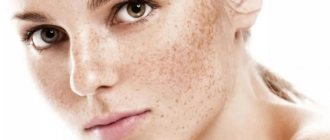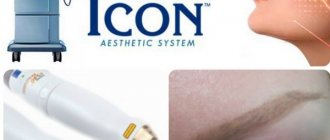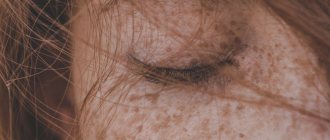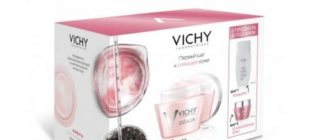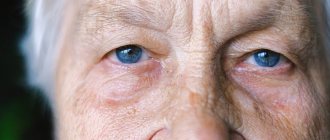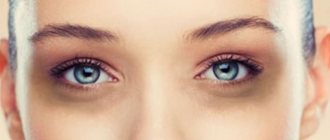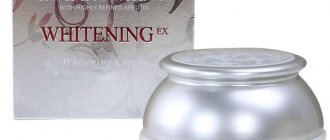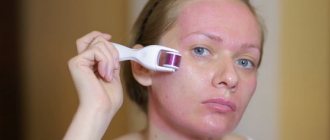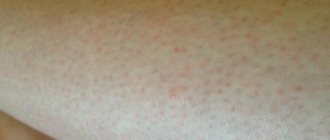What is arbutin
Alpha arbutin is a substance that has antioxidant and whitening properties, which is why it is often added to various cosmetics. This component belongs to the group of phenolic-type glycosides. In other words, alpha-arbutin is a derivative of hydroquinone, a substance that is often included in anti-pigmentation whitening creams. In addition, this component has an antiseptic effect.
Alpha arbutin is a substance that inhibits melanin synthesis
Arbutin is able to block the production of tyrosinase (a copper-containing enzyme), which is involved in the synthesis of melanin pigment. Thanks to this action, pigment spots are lightened and their reappearance at the site of application is prevented.
Many people believe that arbutin is toxic and can cause cancer. However, there is no scientific evidence for this. Similar substances are found in lingonberry leaves and bearberry, which are often used for pathologies of the urinary system. Alpha arbutin is still under close scientific attention. Its study continues to this day.
How arbutin works - video
Composition of arbutin and forms used in cosmetics
Arbutin is also known as hydroquinone-beta D. Hydroquinone is recognized as a toxic substance, so its use in its pure form is prohibited. For cosmetic purposes, exclusively derivative forms are used.
- Alpha Arbutin is a pure form with a high concentration of arbutin. An expensive substance to produce, used in professional salon and luxury cosmetics - high-quality products for any skin type.
- Beta-arbutin is often listed as “arbutin” without the prefix beta. The substance, which is cheaper to synthesize, is included in middle and mass market products. Has a delayed effect, which takes 7-10 days to achieve
- Deoxyarbutin is a synthetic derivative of arbutin with a strong antioxidant effect, which is ten times more effective than hydroquinone and is characterized by less toxicity. Deoxyarbutin is completely safe, remains stable when interacting with other substances, and is well absorbed without causing irritation. Not found on the open market, products are available by prescription only.
The permissible concentration of arbutin in cosmetics is 0.1 - 3%, depending on the type of product.
Features of products with arbutin
Creams with arbutin act gradually. When applied to the skin, the active components are quickly absorbed, interacting with the enzyme tyrazinase, as a result of which the latter substance is not synthesized enough to stimulate melanin production. Problem areas of the skin gradually lose pigment and become lighter. Additionally, such drugs have an anti-inflammatory effect.
Preparations with arbutin are effective in the presence of freckles and small areas of hyperpigmentation. It is unlikely that it will be possible to remove old stains using such a product. It is also important to remember that applying creams with this component to sensitive skin is not recommended. The use of arbutin-based preparations for a month can significantly lighten areas of hyperpigmentation and improve the appearance of the skin.
Products with arbutin can be used if you have freckles.
The advantages of such funds compared to others:
- additional destruction of pathogenic microflora, which is important for acne;
- elimination of inflammatory processes;
- convenient way to use;
- Effective whitening of small age spots and freckles.
Flaws:
- the safety of the substance has not been proven;
- may cause irritation;
- not effective on large areas of hyperpigmentation.
Precautions when using such products:
- Do not apply cream to damaged or irritated skin.
- Do not sunbathe while using such products.
- When using creams with arbutin in the summer, protect the skin from ultraviolet radiation using special means.
- Do not use the cream for longer than the specified period.
- If the pigment spot itches and has an irregular shape, then you can use such products only after consulting a doctor.
- Do not use arbutin cream more than 2 times a day.
Attention! It is recommended to use products with arbutin after consultation with a dermatologist.
With age, my mother began to develop pigment spots. To eliminate them, she tried a cream with arbutin. Unfortunately, it was not possible to achieve a special effect in a few weeks, since the spots were old and quite large. I think the lack of results is also due to the fact that my mother likes to sunbathe often and for a long time, and this aggravates the problem. She plans to continue to use the cream, since such products do not produce an effect immediately, but only after 1–2 months of regular use.
Pigmentary dyschromia: which correction method to choose
Pigmentary dyschromia can be congenital (pigmented nevus, lentigo juvenile, port-wine stain, freckles) and acquired (chloasma, linear pigmentation of the forehead, melasma, pigmented perioral dermatitis, Broca's carotinodermatitis, etc.). Congenital pigmentation, even with a satisfactory effect after hardware intervention, can return in 50% of cases. The maximum effect is achieved by working with acquired pigmentation of various origins (age spots, post-traumatic dyschromia, etc.).
When correcting post-inflammatory and post-traumatic age spots, ablative and non-ablative fractional lasers are not used, since they destroy all layers of the skin using a heating effect. If the patient has a history of post-inflammatory pigmentation, the risk of developing this complication in response to traumatic heat is very high. The procedures of choice in this case are methods using Q-Switch Nd:YAG lasers and IPL systems, which injure the skin at the site of dermal-epidermal contact to a much lesser extent: the former due to an ultra-short pulse, the latter due to contact cooling.
IPL
IPL therapy (intensive Pulsed Light therapy) is in the mainstream of hardware cosmetology due to its accessibility, relative simplicity and safety. The main purpose of IPL is the correction of vascular and pigmentary dyschromia, especially contrasting ones, when an area of skin saturated with melanin is surrounded by a light epidermis. The principle of operation of IPL is the heating of target objects in the skin containing the chromophores melanin and hemoglobin, due to the selective absorption of light energy by these chromophores of a certain wavelength range (usually 400-1200 nm). For IPL devices, a high energy flow and the ability to control the duration of the light pulse are important. The latter is necessary to comply with the rule of thermal selectivity, when the target object in the skin must be heated faster than it cools.
IPL therapy does not require preparation or anesthesia and can be performed on the day of consultation. Visible side effects from its use are an immediate change in the color of the pigment spot after the outbreak and subsequent exfoliation of the epidermis in the affected area. Since IPL is a non-ablative technique, concealer cosmetics can be used almost immediately after the procedure. For more than 20 years of using the IPL method, ways to combine it with other techniques, such as biorevitalization and contouring, have been invented.
Broadband pulsed light does not in any way affect hyaluronic acid preparations or the effects of botulinum toxin, since the point of application of this light is the pigment of the epidermis and the hemoglobin of the vessels of the dermis. A classic example is contouring and a subsequent course of 3-4 IPL procedures aimed at treating rosacea or melasma.
Q-Switch lasers
Q-Switch lasers are a type of laser that uses Q-switching - deliberate degradation of the properties of the active medium, followed by instant restoration of these properties. Such lasers generate powerful ultrashort pulses of several nano- and even picoseconds in length. The idea of using ultrashort pulses in the correction of pigmentation follows from the already mentioned rule of thermal selectivity. Pulses of several nanoseconds in length can effectively heat small targets, such as melanosomes. That is, unlike long-pulse lasers and IPL systems, Q-Switch lasers in the treatment of pigmentation do not destroy tissue structures, but pigment accumulations with dimensions at the level of organelles.
We use Nd:YAG Q-Switch laser to treat pigmentary dyschromia. Procedures using it also do not require preparation and have virtually no recovery period.
How do modern IPL devices work?
The trend in modern cosmetology has become the practical use of devices with preset parameters. If we are talking about IPL therapy, then such a device is M22. He suggests that the doctor select the nature of dyschromia (hemosiderin spots, lentigo, coffee spots, Becker's nevus, hyperpigmentation, etc.), establish the skin phototype according to Fitzpatrick and the depth of the pigment. Then the device independently selects the necessary exposure parameters. If the doctor made a mistake, for example, he identified lentigo as an indication, but indicated the dermis as the level of pigment occurrence (lentigo can only be located in the epidermis), then the device will report that there is no effect corresponding to these parameters. When everything is indicated correctly and the proposed parameters satisfy the specialist, a test flash is performed: if it does not provoke the development of an excessive inflammatory reaction, and the pigment spot darkens and turns gray, you can begin work. If no visible changes occur, the doctor can revise the parameters or set them manually. At the same time, it is possible to change not only the energy density (the higher the energy, the more aggressive the impact), but also the number of pulses, dividing them into subpulses and changing their duration.
Experienced specialists can change absolutely all time and energy characteristics of IPL M22 pulses.
The predecessor of the M22 was the IPL Quantum device, which used only two filter handles (with a wavelength of 560 and 696 nm). For comparison, the M22 has nine replaceable filters: seven conventional ones (from the “shortest” 515-1200 nm to the “longest” 755-1200 nm), as well as two cut-off filters with two passbands (Acne: 400-650 nm and 800 -1200 nm and Vascular: 530-650 nm and 900-1200 nm). Such possibilities for choosing the spectral range allow you to work with both superficial pigment formations (freckles, lentigines) and dermal melasma, as well as hair removal on dark skin phototypes (up to V).
The first IPL devices, if handled improperly, could provoke a burn of the epidermis, since they had limited capabilities for choosing the spectral range and the doctor could not always understand in which layer he was making an impact. Additionally, they were not equipped with the momentum optimization technology used today. Quantum light pulses are not rectangular in shape and therefore produce less predictable effects.
And yet Quantum continues to be one of the favorite devices of many specialists who have been working on it for a long time. Although it requires a great deal of experience from the doctor and does not know how to cope with deep pigmentations, they are not going to abandon it yet, since Quantum perfectly corrects superficial vascular problems.
Modern IPL devices allow you to work even with deep-lying melanin without the risk of damaging the epidermis (the threshold for damage to the epidermis depends on the time of thermal relaxation). To do this, the pulse is divided into three sub-pulses, during each of which the pigment heats up, then there is a pause, during which the chromophore cools down only slightly, but the epidermis cools down almost completely. This is how the doctor achieves the gradual destruction of the pigment without injuring the epidermis. There are filters that work with “narrow” problems: Vascular vascular filter (530-650 nm and 900-1200 nm), Acne filter (400-650 nm and 800-1200 nm).
Modern devices are very sensitive and targeted, so even a novice doctor can quite accurately select the parameters for each nosology.
Another advantage of the new IPL systems is that they combine four techniques: IPL, Nd:YAG Q-switched laser, long-pulse Nd:YAG laser and non-ablative fractional laser Resur FX. This collaboration resulted in protocols for their combined use. If previously two devices were usually used to solve the problem of pigmentation: IPL and a non-ablative fractional laser, and the intervals between procedures were at least 3 weeks, today for M22 there is a PhotoFractional technique proposed by the manufacturer, which combines IPL and a non-ablative fractional laser in one procedure.
Popular creams with arbutin for age spots - table
| Name | Active components | Indications | Contraindications | Adverse reactions | How to use | Course duration | Where can I buy | Price |
| Dr. Rimpler WHITENING |
| Hyperpigmentation |
|
| Daily, 2 times a day, applying to pigmented areas of the skin. | 1 month | Order online | From 4580 rub. |
| Face cream with arbutin and placenta from Roland |
| Age spots and freckles |
| Hypersensitivity reactions. | Apply daily once a day after washing to problem areas. | 4–8 weeks | Order online | From 1125 rub. |
| BeautyMed Arbutin Dermo Active Cream |
| Presence of freckles and age spots |
| Allergic reactions | Used daily 2 times a day. Can be applied to the entire face. | 2–4 weeks | Order online | From 7000 rub. |
| Melanative |
| Freckles and areas of hyperpigmentation |
|
| Apply to problem areas 1 time per day, every other day for a week. Then use daily according to the same scheme. | 3 months | Can be bought at a pharmacy. | From 700 rub. |
Products with arbutin against pigmentation - photo gallery
Dr. Rimpler WHITENING contains licorice extract and other natural ingredients
Roland Arbutin and Placenta Facial Cream contains placenta extract and arbutin
BeautyMed Arbutin Dermo Active Cream moisturizes and whitens the skin
Melanative contains arbutin and kojic acid
Pigmentary dyschromia: difficulties in working
One of the difficulties when working with IPL is the selection of treatment parameters (spectral range, energy flux density, pulse time and intervals between subpulses in one series). They depend on the depth of the pigment, the size and density of the pigment spot, and the skin phototype. Despite the capabilities of modern IPL systems in independently determining the parameters of exposure, their choice in the part that depends on the doctor remains a difficult task.
A complex case can be considered hyperpigmentation of varying depths. Here, when using IPL, successive flashes of different spectral ranges are required, which is achieved by using several filters available in modern devices. Light of different ranges penetrates to different depths, which allows you to consistently influence different levels of melanin.
For example, it is difficult to determine the depth of hormone-dependent melasma. In addition, with increased hormonal levels, pigmentation tends to return, especially if the patient does not comply with the doctor’s recommendations (in particular, limiting time spent in the sun). If there is a predisposition to hormone-dependent melanosis, then insolation increases the risk of their relapse.
Post-inflammatory pigmentation that occurs after exposure to a CO2 laser is not always amenable to rapid treatment, since not only pigment is present in the area of interest, but also an inflammatory process. In this case, you should wait until the inflammation subsides.
Clinical case 1
Patient F., 30 years old, complained of age spots in the cheekbone area. From the anamnesis: Pigment formations appeared after pregnancy. Diagnosis: pregnancy melasma. Purpose: single IPL procedure. The work was carried out at different levels of pigment occurrence, so two filters were used: a 640 nm filter, three subpulses, energy - 21 MJ; filter 560 nm, one pulse, energy - 1 ZmJ.
Patient F.: a — before, b — after one phototherapy procedure.
Result: noticeable lightening of the pigment over the entire area, except for the edges of the periorbital zone.
Clinical case 2
Patient T., 43 years old, came in regarding pigment spots on her face. From the anamnesis: 1-1.5 years ago, 2 IPL procedures were prescribed to combat hyperpigmentation and have an anti-aging effect. Diagnosis: melasma. Purpose: procedure using a Q-Switch laser to combat pigmentation. Spot diameter 6 mm, energy 1.6 J; spot diameter 3.5 mm, energy – 4.6 J. After complete restoration of the skin, the IPL procedure will be performed again to act on the vascular component.
Patient T.: a, c - before; b, d — after 1 procedure with 1 using Q-Switch laser.
Result: significant pigment lightening after the first procedure.
IPL and lasers against pigmentary dyschromia: key points
- When correcting post-inflammatory and post-traumatic age spots, Q-Switch Nd:YAG lasers and IPL systems are used as the least traumatic.
- The current trend is the use of IPL devices with preset parameters. For example, M22 offers the doctor to select the nature of dyschromia, skin phototype and pigment depth, and then selects the treatment parameters.
- Modern IPL devices allow you to work even with deep-lying melanin without the risk of damaging the epidermis.
- Q-Switch lasers are capable of generating ultrashort pulses of several nano- and even picoseconds in length, heating small targets, such as melanosomes.
- Today, techniques using IPL and non-ablative fractional laser can be combined in one procedure (previously, the intervals between procedures were at least 3 weeks).
- A complex case can be considered the correction of pigmentation of different depths, as well as post-inflammatory pigmentation after exposure to a CO2 laser.
At Premium Aesthetics you can purchase the following types of cosmetology equipment:
|
|
Beneficial properties of arbutin
In addition to its pronounced skin-lightening properties, expressed by reducing melanin production, arbutin provides protection against UV radiation. Using cosmetics with the component gives the following effect:
- elimination of freckles and pigmentation of various types;
- whitening excessively tanned skin and returning dull skin to its normal appearance;
- has an antiseptic effect on the dermis prone to irritation and rashes;
- removes toxins and waste;
- eliminates swelling;
- evens out skin tone, restoring elasticity and softness;
- successfully used in the treatment of dermatological problems such as lentigo, melasma;
- interacts with most components without causing adverse reactions;
- Let's say in a complex composition with other lightening agents.
Arbutin eliminates types of pigmentation, regardless of origin. In Korean cosmetics it replaces more aggressive whitening ingredients. In addition, it acts safely and protects the skin from the negative effects of ultraviolet radiation.
